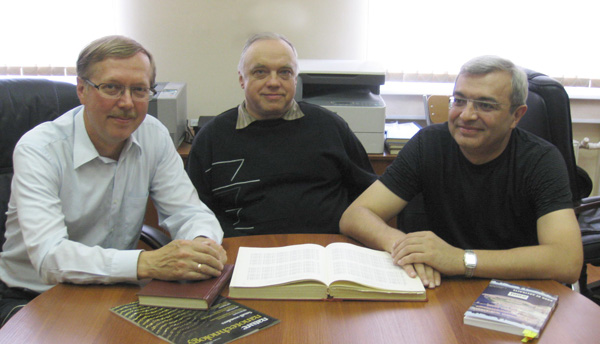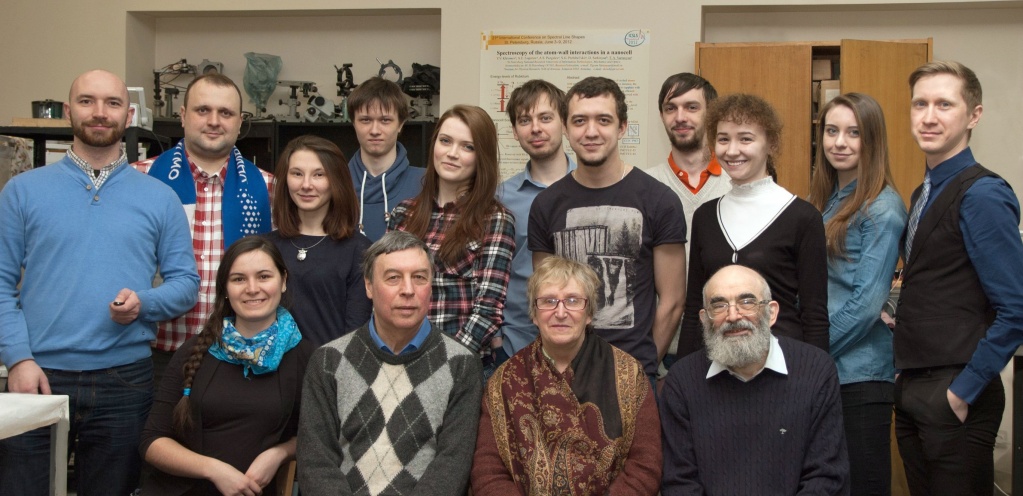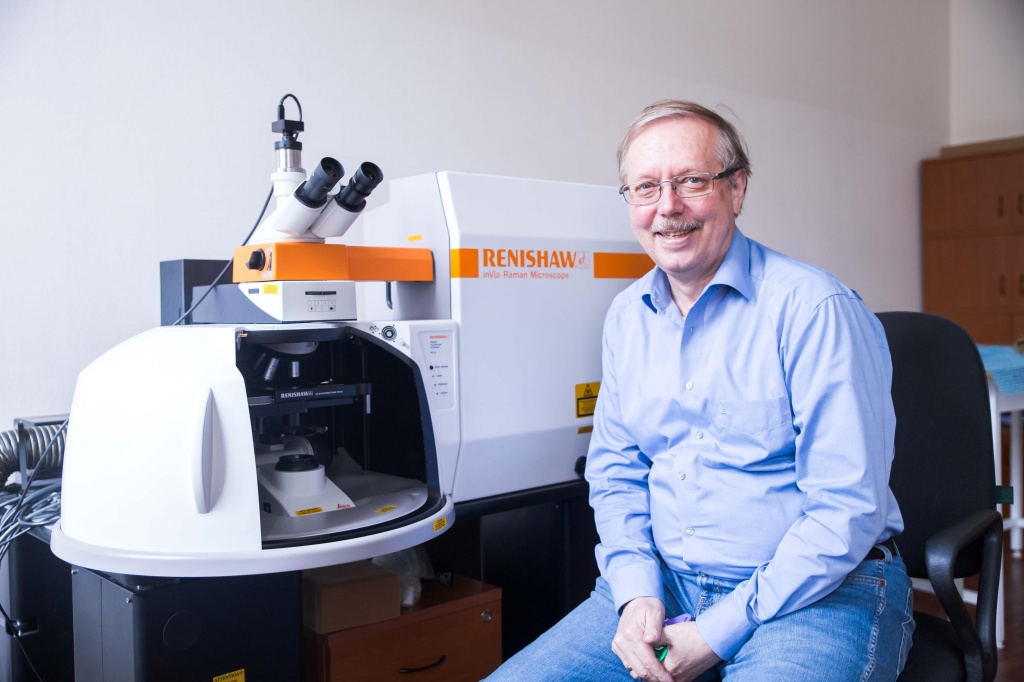Research areas
1. Chiral nanocrystals

Chirality is one of the most fascinating phenomena in the natural world. Chiral compounds have already played an extremely important role in the fields of chemistry, pharmacology, biology, and medicine. Currently chiral nanocrystals are an emerging class of nanostructures that attract considerable attention because the chirality of the nanocrystals can have a tremendous effect on the nanotoxicology and nano-bio-technology fields. The biocompatibility of chiral nanocrystals can be improved dramatically compared to achiral nanocrystals. It will be possible to embed them in biosystems playing by molecular “rules”. We have learned how to separate enantiomers of nanocrystals, we have shown that chirality is an intrinsic property of semiconductor nanocrystals, and now we are working on further investigation of different aspects of interaction between chiral nanocrystals and biosystems.
Research group: Anatoly Fedorov, Alexander Baranov, Yurii Gun'ko, Vladimir Maslov, Maria Mukhina, Evgeny Kundelev
2. Infrared quantum dots
One of the key problems in modern materials science is the creation of new functional materials with improved optoelectronic and operational properties that can be purposefully changed depending on the field of their application. This is possible with the use of nanostructured multicomponent materials combining the unique properties of nanoobjects of different nature, such as ultra-thin two-dimensional nanomaterials (for example, graphene), metallic nanoparticles, and semiconductor nanocrystals. Semiconductor nanocrystals with electronic transitions in the near-infrared spectral range are promising materials for many applications, such as solar energy, telecommunications systems, and biomedicine.
Within the framework of our research projects we study PbS quantum dots with optical transitions in the spectral range of 0.8–2.0 µm. These quantum dots possess some unique properties, such as efficient multi-exciton generation, large static dielectric constants, highly symmetrical sodium chloride structure, and narrow fundamental bandgaps. Small and equal masses of the charge carriers and large Bohr radius (18 nm) let one use PbS quantum dots as a model object for investigation of the strong quantum confinement regime. PbS quantum dots of different sizes demonstrate unusual optical properties, namely, large Stoke shift and surprisingly long photoluminescence decay times. Moreover, they possess anomalous size dependence of their photoluminescence lifetimes, which has never been reported for other semiconductor quantum dots. Another interesting and perspective feature of these quantum dots is the ability to easily form ordered 2D and 3D structures, named superlattices and supercrystals. Such structures are based on a self-organization process and may become a new platform for high-performance solar cells and light detectors.
Research group: Alexander Baranov, Petr Parfenov, Elena Ushakova, Alexander Litvin, Yulia Gromova
3. Theoretical investigation of nanocrystals
The theoretical group of the laboratory "Optics of quantum nanostructures", together with theoreticians from other laboratories, conducts research on the spectroscopy of anisotropic and chiral nanostructures, the study of vibrational resonance in quantum dots, and also the properties of two- and three-dimensional quantum dot supercrystals.
Research group: Anatoly Fedorov, Eugene Perlin, Ivan Rukhlenko, Mikhail Leonov, Nikita Tepliakov, Anvar Baimuratov, Vadim Turkov
4. Metal nanoparticles with plasmon resonances for optoelectronics and biomedicine

In the laboratory “Surface Photophysics” we investigate composite materials with nanoparticles of noble metals. An attractive feature of noble metal nanoparticles is that all of their conduction electrons oscillate collectively in response to a external electromagnetic field. Due to this, their response to the external stimulus is larger as compared to other resonance systems. Simultaneously, a region of greatly enhanced electric field strength is formed in the close proximity of the nanoparticles. By placing in this region different resonance systems that possess useful but weak response to the electromagnetic field one can attain considerable enhancement of absorption and luminescence, as well as the rates of other processes. The obtained by us novel composites comprising epitaxial quantum dots in monocrystalline gallium arsenide are of special interest due to the feasibility of their use in optoelectronic devices. We also study composites with organic dyes, especially those that form J-aggregates. The application of nanoparticles in the investigation of processes in living cells is also underway.
Research group: Tigran Vartanyan, Nikita Leonov, Nikita Toropov, Igor Gladskih, Anton Starovoytov
5. Hybrid structures based on semiconductor nanocrystals
The development of new types of hybrid nanostructures in which the properties of individual components are uniquely combined together is a modern trend in nanotechnology. Currently, hybrid nanostructures based on colloidal semiconductor nanocrystals have a broad application range - from their use as LEDs, photovoltaic and photocatalytic elements and sensing systems to biomedical applications as luminescent biomarkers, drug delivery systems, and new photosensitizers for oncology theranostics. The goals of our research are the development the hybrid nanostructures based on semiconductor nanocrystals using organic molecules, graphene, and TiO2 nanoparticles for sensing and biomedical applications as well as the fundamental investigation of the pathways of electronic relaxation in these systems. For biomedical applications in particular, the chiral properties of hybrid nanostructures based on chiral semiconductor nanocrystals and molecules could play a key role in the functionality of these systems, and therefore the investigation of how the chiral properties of hybrid nanostructures influence their optical properties and functionality in living systems is also comprised in our research interests.
Research group: Anna Orlova, Vladimir Maslov, Yulia Gromova, Anastasyia Visheratina, Kirill Annas, Ekaterina Kolesova, Ivan Reznik, Anastasia Bazhenova, Daria Lipatova, Pavel Ilyin
6. Structure and optical properties of carbon nanomaterials: nanodiamonds, nanographite, carbon nanotubes, and graphene

At present, the class of nanocarbon materials includes a variety of diverse structures of various dimensions, such as nanographites, nanodiamonds, nanotubes, and graphene. These materials possess unique combinations of electrical, mechanical, thermal, optical and other properties and can be used in a wide range of actual devices for nanoelectronics and nanophotonics, such as energy converters, energy storage devices, sensors for various substances, as well as for the creation of a variety of composite materials. Attaining optimal functional characteristics of nanocarbon materials, in particular luminescent properties, is directly related to their internal structure, which may change considerably depending on the synthesis conditions and additional processing. Thus, one of the main advantages of nanocarbon materials is the ability to tune and obtain desired optical properties due to variations in their internal structure. However, presently there is still no complete understanding of the mechanisms of growth of nanocarbon structures, as well as of the dependence of their optical properties on structure. Within the framework of our projects, in cooperation with laboratories for the synthesis of luminescent nanodiamonds, nanographites and graphenes in the USA, France and Japan, we investigate the effect of the structure and energy dissipation in nanocarbon materials on their optical properties, using the most modern experimental techniques of luminescence spectroscopy and micro-Raman analysis.
Research group: Alexander Baranov, Kirill Bogdanov, Mikhail Baranov, Marianna Zhukovskaya, Anna Volokitina
7. Laser cooling and spatial localization of nanoobjects
The studies are concerned with the translational and internal cooling of nanoobjects by means of the interaction with external electromagnetic and electric fields. It includes spatial localization of solid state and bio- nano objects in optical tweezers and trapping of complex objects in nonlinear RF traps. Additionally, new mechanisms of optical cooling of systems containing rare-earth ions, quantum wells and quantum dots in the field of high-intensity laser radiation are investigated. Among these mechanisms are tunneling of free charge carriers in heterostructures, Raman processes of pumping of media with doped systems, and the processes of spitting electron energy levels in various solid system when exposed to high-intensity radiation pulses.
Research group: Eugene Perlin, Yuriy Rozhdestvensky, Andrei Ivanov, Semen Rudyi, Ruslan Siryi, Tatiana Vovk.
8. Nonlinear processes of optical excitation and ultrafast optical switching in bulk crystals and nanostructures
The studies concern fundamentally new optical processes in intrinsic and extrinsic crystals and nanostructures of various types. The processes are distinguished by the extremely high degree of optical nonlinearity and based on the effects associated with transformation of electron band spectra of materials in the field of a high-intensity laser irradiation or with photon-avalanche-type phenomena. The key component of the last-mentioned phenomena is defined by electronic transitions such that the corresponding elementary event involves the absorption of one or several photons and the energy transfer between electrons. Research is carried out in the following fields (i) the theory of multiphoton transitions in solids under the action of powerful femtosecond pulses; (ii) the nonlinear polarization effects in transparent bulk crystals and nanostructures; (iii) the theory of ultrafast optical switching in solid state systems; (iv) the new types of photo-induced kinetic processes in crystals and nanostructures.
Research group: Eugene Perlin, Andrei Ivanov, Ruslan Levitskii, Mikhail Bondarev, Kirill Eliseev, and Alexei Popov